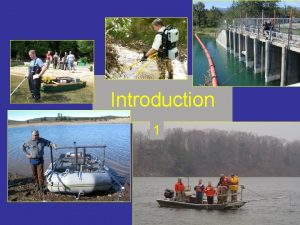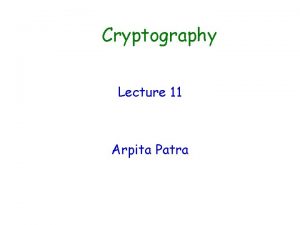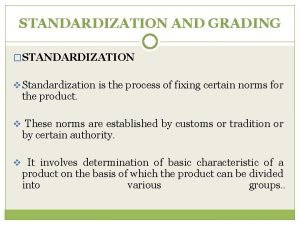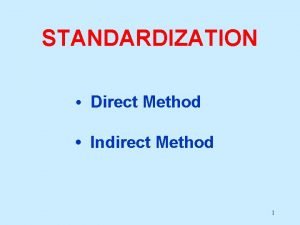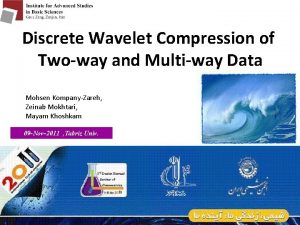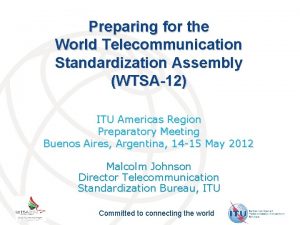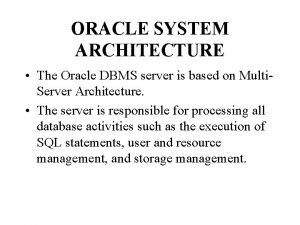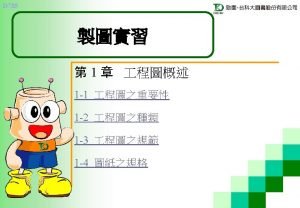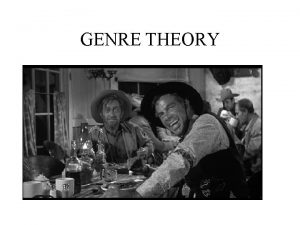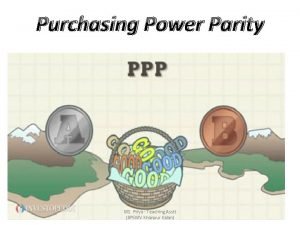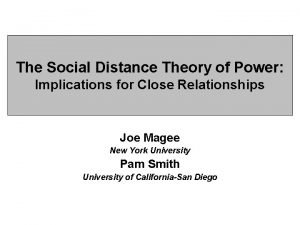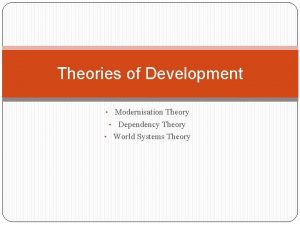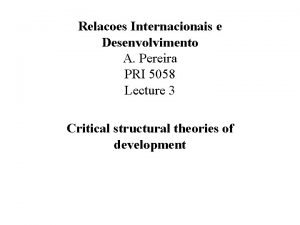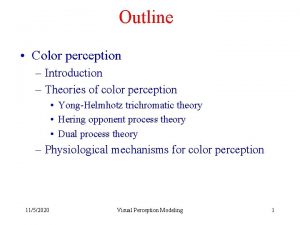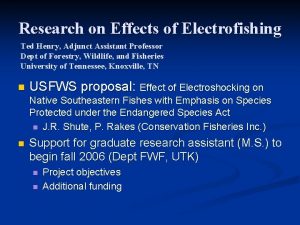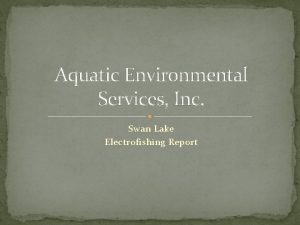Electrofishing Theory Power Standardization Daniel E Shoup Department




































































- Slides: 68

Electrofishing Theory & Power Standardization Daniel E. Shoup Department of Natural Resource Ecology & Management Oklahoma State University

Standardized Sampling A. Important sampling considerations 1. Goal of sampling = provide information that reflects what is really present in the lake 2. Our ability to do this is a function of two attributes of our sampling equipment a. Accuracy = how close the sample reflects the real distribution being sampled (opposite = bias) b. Precision = how reproducible repeated samples are (inverse of variability).

c. Bias = sampling values such that they are not collected in proportion to what is there in the statistical population —i. e. , systematic lack of accuracy. Precise Imprecise Biased Unbiased 1) For example say you sample saugeye with a gill net and the mesh size you use is more likely to capture a big individual than a small individual. a) Leads to higher mean value (and possible smaller variance) than what the statistical population has. 2) Keep in mind, most sampling devices/methods produce a bias (size, sex or age bias).

Standardized Sampling CPUE 3. Sampling via electrofishing is supposed to provides a relative measure of abundance (CPUE). a. Assumes CPUE is proportional to true density. Slope = proportional catch constant—usually unknown True density of fish b. One condition for this to be true is that the equipment is equally efficient every time it is used. c. Any factor that effects electrofisher efficiency needs to be accounted for and “standardized”

Standardized Sampling d. Some factors can have a dramatic effect on electrofisher efficiency (i. e. , larger effect than the effect of fish abundance itself!)

Standardized Sampling Data from Burkhardt & Gutreuter 1995 NAJFM 15: 375 -381. Yikes!!! 41 x difference!

Standardized Sampling d. Some factors can have a dramatic effect on electrofisher efficiency (i. e. , larger effect than the effect of fish abundance itself!) 1) 2) 3) 4) Time of day Turbidity Season/temperature Boat driving decisions (boat speed, hover cover or not, circle back or not for late-surfacing fish, etc. ) 5) Electrode and boat configuration (number of droppers, diameter of droppers, spacing between booms, etc. ) 6) Pulse rate, duty cycle, AC vs DC 7) Peak power applied to fish e. If we do not standardize these types of things, we are probably just wasting time by sampling (the collected information is useless at best, and dangerously misleading at worst)

Electrofishing B. Background information on electricity: 1. Electricity is a flow of charged particles (usually electrons) from area of higher electronegative potential to an area with lower electronegative potential. 2. Measurable attributes of electricity: a. Voltage - the magnitude of difference in the electronegative potential (measured in volts). 1) Analogous to pressure in your plumbing system. b. Current - the rate of electron flow (measured in amps or Coulombs/sec). 1) Analogous to rate of water flow in plumbing (gallons/min).

Electrofishing c. Resistance - the “friction” of electron flow caused by lack of conduction of material conducting electricity (measured in ohms). 1) Analogous to the size of pipe in plumbing, but higher resistance would be analogous to a smaller pipe. 2) Ohm’s law relates these three Current = voltage/resistance d. Conductance – the inverse of resistance (1/resistance); ability to carry current (measured in mhos or Siemens [S…or μS for the range we normally see in lakes]). e. Power – the work that can be done by electric current. 1) P = V x I (there are other equations for power we will learn later) Where: P = power (watts) V = voltage (volts) I = current (amps)

Electrofishing C. Theory of using electricity to capture fish: 1. The effect of electricity on fish is dependent upon the amount of power (watts) that travel through the fish’s body. 2. To understand this, we must look at electric flow in 3 D…. but let’s start by looking at more typical 1 -dimensional models (e. g. , household wiring). a. Ohm’s law relates volts, current, and resistance: Where: R = resistance (ohms) V = voltage (volts) I = current (amps)

I will skip this content…read on your own Theory of using electricity to capture fish: b. Using our equation for power (P = V x I) and ohms law we can determine the total power of a system (circuit) several ways. 1) P = V x I 2) V = R x I, so… P = R x I or P = R x I 2 a) So we can calculate power knowing only current (amps) if the resistance is constant (as would be the case in your boat’s wiring) 3) Alternatively, P = V x I can be combined with to get a) So we can calculate power knowing only voltage (assuming constant resistance). Where: R = resistance (ohms) We will use these relationships later to provide “shortcuts” for how we need to setup our pulse box to obtain a desired power output V = voltage (volts) I = current (amps) P = power (watts)

Theory of using electricity to capture fish: c. When electrofishing, we need equations to express power distribution in 3 -D: 1) Resistance becomes Resistivity = cumulative amount of resistance encountered over some distance (Ohms * cm) 2) Voltage becomes Voltage Gradient = change in volts over distance (V/cm) 5 v 1 cm 4 v 3) Current becomes Current Density = amount of current that passes an area (A/cm 2) Amps

Theory of using electricity to capture fish: 3) So our power equation can now be updated as well: P=V*I → (µW/cm 3) = (V/cm) * (A/cm 2) Power = volts * amps → Fig 8. 3 Power Voltage Current = Density Gradient * Density

Theory of using electricity to capture fish: 3) So our power equation can now be updated as well: P=V*I → (µW/cm 3) = (V/cm) * (A/cm 2) Power = volts * amps → Power Voltage Current = Density Gradient * Density d. It is the peak power density (µW/cm 3) applied to the fish (not the water) that effects the fish’s behavior. 1) Historically have measure average amps (or some times volts) at the electrode. a) Power involves both volts and amps. b) Fish behavior is dictated by peak power (not average). c) Smith-Root amp meters only measure AVERAGE amps…not PEAK amps (average values are useless). a) Average measures are mostly effected by pulse rate (how much on vs off time).

Pulsed DC current - 60 pps, 5 ms pulse width Avg volt = 150, peak volt 300 v 5 ms on and 11 ms off Voltage A. Yet 5 ms * 6 pulses in 96 ms = 30 ms on-time 300 v *30 ms on time = 9, 000 v total 9, 000 v / 96 ms total = 93. 75 v avg 0 96 ms Yet both have same ability to immobilize a fish (both have 300 Pulsed DC current - 60 pps, 10 ms pulse width peak volts) Voltage Avg volt = 150, peak volt 300 v 10 ms on and 4 ms off 10 ms * 6 pulses in 96 ms = 60 ms on time 300 v *60 ms on time = 18, 000 v total 0 96 ms 18, 000 v / 96 ms total = 187. 5 v avg

Theory of using electricity to capture fish: 1. The effect of electricity on fish is dependent upon the amount of power (watts) that travel through the fish’s body. 2. To understand this, we must look at electric flow in 3 -D 3. Conductivity (of fish and water) determines how much of the 3 -D power density applied to the water actually goes into the fish. a. Conductivity changes resistance…so it alters power: Remember, P = V x I but also P = R x I 2 and 1) So with a given amount of power at the electrodes, the amount of power that flows through the water totally dependent on water conductivity (i. e. , the inverse of its resistance). 2) With a given amount of power at surface of the fish, the conductivity of the fish’s flesh will determine how much power enters the fish. a) Note…also a function of whether a better path (water around fish) exists.

Theory of using electricity to capture fish: Smith-root GPP manual Fig 2 Power flows evenly through fish and water – easiest to calculate power needs Power flows more easily through fish, but requires more voltage to “jump” from electrode to fish as water not as conductive Power flows more easily through water, requires high current to force some into the fish

Theory of using electricity to capture fish: 3) Water conductivity changes with temperature, so meters may use one of two types of conductivity measurements. a) Specific Conductance – standardized to the conductivity the water would have at 25 o. C i. Most people use conductivity to indirectly measure salt concentration…and want to remove any temperature effects. ii. On cheaper meters, this will be the only thing measured b) Ambient Conductance – the actual electrical-carrying capacity of the water at whatever temperature existed when measured. i. This is what we are after when electrofishing. ii. All “conductivity” references in this lecture refer to ambient conductivity. iii. Better meters can measure this directly, but you need to be sure it is set up to do this (specific C will be default). iv. If your meter does not measure this, you can convert specific → ambient

Theory of using electricity to capture fish: iv. If your meter does not measure this, you can convert specific → ambient v. For example: You measure specific conductivity of 264μS/cm on a day when the actual ambient temperature was 17 o. C. What is the ambient conductivity?

Theory of using electricity to capture fish: 3. Ambient conductivity (of fish and water) determines how much of the power density applied to the water actually goes into the fish. b. As a hypothetical example: 1) Suppose 60 µW/cm 3 must be applied to a fish for it to be immobilized. 2) The fish has a body conductivity of 115 µS/cm 3) If the water has 115 µS/cm conductivity, then need to apply 60 µW/cm 3 to the water (100% efficiency of transfer). 4) If water conductivity is 1, 000 µS/cm, then might need 162 µW/cm 3 power in the water to attain 60 µW/cm 3 in the fish. a) We will learn how to precisely calculate the required power in a minute.

Power density in water to achieve power density of targeted µW/cm 3 in fish Power in water (µW/cm 3) Fish conductivity = water conductivity (100 -120 μS/cm) 7500 Overcome with increased Voltage 6500 5500 Overcome with increased Amperage 4500 3500 2500 1 10 1000 Conductivity (µS/cm)

Theory of using electricity to capture fish: 4. To summarize, if we want to standardize our electrofishing effort so we can compare catch rates of 2 samples, we must standardize the peak power applied to the fish. a. Power needed in water to achieve this changes as the resistance (conductivity) of the water changes… b. Must measure water conductivity (convert to ambient if your meter only has specific conductivity), then adjust power output to compensate. c. This can be precisely calculated…and it is not as hard as it looks (but buckle up…it may be a bumpy ride).

Standardizing electrofisher power output: D. How to configure the electrofisher’s settings to have consistent power application to fish. 1. I can’t directly measure the power entering the fish…how can I determine the best power settings to use (volts and amps…or just amps as GPP [generator-powered pulsator…Smith-Root’s pulse box] provides)? a. First step – Pick the amount of power you want to go into the fish (Dm), then calculate power needed in water (Da) to do this at today’s measured water conductivity. 1) Using model by Kolz this can be calculated (1989 US Fish & Wildl Serv. Tech rept. 22: 1 -11; Confirmed by Miranda & Dolan 2003 TAFS 132: 1179 -1185. ) Dm = Power density (µW/cm 3) transferred to fish. Da = Power density (µW/cm 3) transferred to the water. Cf = Conductivity of fish’s body (µS/cm). Cw = Conductivity of water (µS/cm). a) So how much power applied to the fish (Dm) is needed to immobilize a fish? i. Requires research for different sizes/species…i. e. , Miranda 2005 NAJFM 25: 609 -618

Dm = Peak power density applied to the fish Below this line (Dm = 2, 000) , no fish were injured Square = injured fish Triangle = no fish injured at highest power tested Circle = fish fully immobilized Dm = 300 Dm = 60 So for adults Dm = 60 is good target (probably want 300 for juveniles)—but how do I produce this with my pulse box? Juveniles Adults From: Miranda 2005 NAJFM 25: 609 -618 1 or 6 after species’ name indicates 1 or 6 ms pulse width. Numbers in parentheses indicate weight range tested in grams.

Standardizing electrofisher power output: b) If we pick a target power density we want to apply to the fish (Dm), we can rearrange the equation to solve for the power we should apply to the water (Da) to achieve this result (given a measured ambient water conductivity). or Dm = Power density (µW/cm 3) transferred to fish (use 60 µW/cm 3 for adults… 200 -300 for juveniles). Da = Power density (µW/cm 3) transferred to the water. Cf = Conductivity of fish’s body (µS/cm). Cw = Conductivity of water (µS/cm).

Standardizing electrofisher power output: PCF (X-fold increase in power needed) c) Think of this as a Power Correction Factor (PCF) Fish conductivity = water conductivity (100 -120 μS/cm) 3 Overcome with increased Amps Volts 2 1 1 10 1000 Conductivity (u. S/cm)

Standardizing electrofisher power output: I will skip this content…read on your own b. Second step= configuring my electrofisher to produce Da (3 D power in water). The electrofisher only tells me amps & volts sent to electrodes (1 -dimensional—this is Pa not Da). 1) So…we need to develop an equation to describe the relationship between Pa and Da after making measurements of both parameters at a variety of electrofisher settings: a) We can measure Pa (1 -D power from electrofisher) as: P=Vx. I i. This can be easily done with an oscilloscope that records peak voltage X peak amperage (more details on how to do this later in notes). b) To measure Da (3 -D power density in water), we need a different approach because 3 -D current is hard to measure. i. Remember, we have several 1 -D equations for power: P=Vx. I P = R x I 2 Where: R = resistance (ohms) V = voltage (volts) I = current (amps) P = power (watts)

I will skip this content…read on your own Standardizing electrofisher power output: i. Remember, we have several 1 -D equations for power: P=Vx. I P = R x I 2 Where: R = resistance (ohms) V = voltage (volts) I = current (amps) P = power (watts) ii. So by using the 3 rd equation, we get around needing to measure current (I) iii. To scale this 1 -D equation up to a 3 -D equation (as needed in a lake) we make the following changes: R-resistance (ohms) becomes Resistivity (ohms*cm) V-voltage (volts [V]) becomes Voltage Density (V/cm) I-amperage (amps [A]) becomes Current Density (A/cm 2) P-power (watts [W]) becomes Power Density (μW/cm 3) So… iv. We typically measure the resistance of water indirectly by measuring its inverse…conductivity (units in 3 -D space are typically μS/cm…note 1 mho/cm = 1 S/cm).

I will skip this content…read on your own Standardizing electrofisher power output: iv. We typically measure the resistance of water indirectly by measuring its inverse…conductivity (units in 3 -D space are typically μS/cm…note 1 mho/cm = 1 S/cm). Remember v. So we can measure total power as: With 3 -D units (μW/cm 3) = (μS/cm) * (V/cm)2 vi. To put this into the form used in the literature, let’s write this as… Where: Da = power density in the water (µW/cm 3) Cw = Water conductivity (µS/cm) V = voltage gradient (volts measured over distance “d”) d = distance over which voltage was measured (cm)

Standardizing electrofisher power output: c) Remember, our goal here is to find a way to relate Pa (1 -D power at electrodes) with Da (3 -D power in water). d) To do this, we need to run electrofisher at several different power output settings (Pa) and measure resulting Da: i. Pa = peak voltage X peak amperage (more details on how to do this using oscilloscope later in notes). ii. Da = voltage gradient (V/cm) around electrodes then solve the equation given the water conductivity the day we measured it (see Miranda 2005 NAJFM 25: 609 -618). Da = power density in the water (µW/cm 3) Cw = Water conductivity (µS/cm) V = voltage gradient (volts measured over distance “d”) 1 cm apart = d d = distance over which voltage was measured (cm)

I will skip this content…read on your own Standardizing electrofisher power output: 1 cm apart iii. So, how do we measure voltage gradient? (Miranda 2005 NAJFM 25: 609 -618). iv. Use an insulated rod (e. g. PVC pipe) with 2 wires that extend 0. 5 cm past the end (e. g. , silicone wires in place). v. Remove insulation from about 2 mm of each wire. vi. The two wires should be 1 cm apart (or some other precisely known distance…but adjust “ 1 cm” in equation on next slide accordingly). vii. Connect the other end of each wire to volt meter that can measure peaks of pulsed currents (i. e. , oscilloscope or scope meter). viii. Measure peak volts on oscilloscope/voltmeter by rotating the insulated rod until the largest peak voltage is found. This is volts/cm if wires are 1 cm apart. (if they are 3 cm apart, divide by 3 to get volts/cm) ix. Do this several places around electrodes…voltage gradient will vary so we need several measurements. x. Also need to measure conductivity (u. S/cm) with a conductivity meter (just measure once).

1. Measure 36 locations. 2. Change power output (measure/record total power output) and repeat 36 measurements in water 3. Do that several times (10 – 13 different power settings, each with 36 measurements)

Standardizing electrofisher power output: viii. Plug each voltage reading into power equation along with conductivity to find the Da for each measurement. Where: Da = power density in the water (µW/cm 3) Cw = Water conductivity (µS/cm) V = voltage measured with Oscilloscope (“ 1 cm” assumes wires used with oscilloscope were 1 cm apart…if not change to # of cm used) ix. We want to summarize all these Da values taken at same electrofisher settings (Pa) into a single value. • We could average, but the 5 th percentile as Miranda suggested may be better (so 95% of electric field is >Da…means 95% of my field should be capable of stunning fish).



Standardizing electrofisher power output: e) Use the square root of the 5 th percentile of Da (3 -D power density in water) and Pa (1 -D power=volts x amps at electrodes) from each different electrofisher setting tested to develop a linear regression equation. i. Using square root linearizes the relationship ii. Using 5 th percentile gives you the power level where fish will be immobilized within 95% of the area around electrodes. iii. This equation allows you to measure volts/amps at electrofisher (Pa a 1 -D measure) and know what the Da will be in the water (3 -Dimensionally). f) I will give an example of how to do this later.

Standardizing electrofisher power output: c. So with all the above information, we have a 2 -step process to set up our electrofisher in order to apply a desired peak power to the fish (Dm): 1) Use first equation to determine Da we need to provide our target Dm in the fish (i. e. , adjusts for changes in water conductivity). D = Peak power density (µW/cm 3) m transferred to fish (Miranda 2005 suggests 60 u. W/cm 3 for adult fish). Da = Power density (µW/cm 3) transferred to the water. Cf = Conductivity of fish’s body (µS/cm 100 – 115 works for most species). Cw = Conductivity of water (µS/cm). 2) Use our Pa to Da regression equation to determine the peak power (Pa = V * amp) that should be produced by our electrofisher so that we generate this Da.

d. The above info in can be a bit confusing…Let’s review the big picture here: 1) 2) 3) Goal = power density (3 -D) applied to fish’s body (Dm) = 60300 μW/cm 3 (based on research from Miranda 2005). To adjust for effects of water conductivity, Dm is related to Da (power density applied to water) by equation. Da (a 3 -D measure of power) can be related to Pa (watts of power = volts* amps… 1 -dimensional) so we can generate a desired Da by setting volts & amps on our pulse box…but will need to be measured on each boat (is boat-specific): a) To get this Da to Pa (watts) relationship, you need: i. Conductivity of water ii. Map the relationship between Pa at electrodes and Da in water using an oscilloscope (or use Miranda’s) relationship may change for a given boat over time as boat hull or electrodes corrode. 4) So the entire process is: Determine desired Dm (power density in fish [3 -D]) Da (power density in water [3 -D]) Pa (power at electrode[1 -dimensional]) set volts x amps on pulse box to equal desired Pa.

Standardizing electrofisher power output: Pa power at electrodes 36 measurements of voltage across 1 cm distance (d) around electrodes √Da = 0. 0023*Pa + 1. 60 Calculate 5 th percentile of all 36 Da values Repeat at 12 different power settings gives equation Da power in water Dm power needed in fish

Standardizing electrofisher power output: 2. One last problem to get past…GPP does not give volts…only amps (and its amp meter only measures RMS amps, not peak amps). a. So how do I determine the settings that will provide the desired amount of power (the Pa calculated as we just covered)? b. Two methods: 1) Method 1 = Measure peak V (voltage) and I (current) directly using a peak voltage meter and peak amp meter (note GPP amp meter is not accurate Pope et al. 2001 NAJFM 21: 343 -357): a) Need portable oscilloscope or a fancy volt-ohm meter that can measure peak voltage/amperage (called scopemeters). - Pulsed DC current changes many times/sec so typical volt-ohm meter will not be accurate (will either jump around or give average but not peak value). b) Connect one of the two leads on the meter to the cable going to the electrode, the other to ground (boat hull, cathode wire, etc. ). c) Read peak voltage while the system is running and configured for normal electrofishing (in water with electrodes at normal position). - Is best to install a hard-wired outlet for this for safety. d) Use a DC current clamp around any part of anode wiring (works through insulation-“Hall Effect” current meter) to read peak current level. e) Adjust % of range knob (simultaneously changes volts and amps) until measured volt * amp = desired Pa.

Standardizing electrofisher power output: a. Two methods: 1) Method 1 = Measure directly by installing a peak voltage meter and peak amp meter (note GPP amp meter is not accurate Pope et al. 2001 NAJFM 21: 343 -357): 2) Method 2 = Measure resistance of wiring in your boat and use the ohms law relationships to avoid having to measure voltage. Remember, P = V x I but also P = R x I 2 and P=power V=voltage a) So we can calculate power (our targeted Pa) knowing only R I=current (resistance = function of our boat wiring [a constant] and R=resistance water conductivity [we measure every time we go out]) and I (amps …we will adjust this with % of range knob to get the desired power output). b) If P is known (i. e. , it is your target Pa value) and R is known (you measure it once and assume it has not changed), then: Where: P = the Pa value you desire R = measured electrode resistance I = amps needed to produce Pa

Standardizing electrofisher power output: c) We must adjust resistance to match the current water conductivity we observe today as follows: Where R 1 = measured resistance of system at C 1 R 2 = resistance at new conductivity C 1 = water conductivity where R 1 was measured C 2 = new water conductivity c) For above example, we needed Pa = 4, 210 watts in water with 300 μS/cm conductivity. -if boat resistance was previously measured in water with 250 μS/cm and found to be 10 ohm…

Standardizing electrofisher power output: c) For above example, we needed Pa = 4, 210 watts in water with 300 μS/cm conductivity. -if boat resistance was previously measured in water with 250 μS/cm and found to be 10 ohm… So adjust % of range knob until current clamp gives peak amperage of 22. 48 Note both voltage & amperage are changing when you change the % of range knob on a Smith-Root GPP …but we do not need to measure V because ohms law takes into account that with constant resistance, changes in amperage must go with definable changes in voltage at the same time.

Standardizing electrofisher power output: e) So how do you measure resistance of my boat? 1) Follow instructions for measuring peak voltage and peak current given in Method 1 above. 2) Calculate resistance as 3) Make sure you record water conductivity so you can adjust resistance for future water conductivities. 4) Make measurements at several different power settings on the GPP and average resulting resistance. 5) This should be done on AC (not DC) setting to avoid bias produced by “Helmholtz effect”.

Standardizing electrofisher power output: 3. So to review the entire process: a. Determine target Dm (power applied to fish). 1) if no better info, use 60 µW/cm 3 for fish > 150 mm TL; use 200 -300 µW/cm 3 for fish < 80 mm TL (from Miranda 2005). b. Desired Dm (power in fish) Da (power in water). c. Da (power in water) Pa (power at electrode). 1) Map voltage gradient around boat using oscilloscope and probe with 1 -cm electrode spacing, then build graph/regression equation. 2) Or use Miranda 2005 graph and assume your boat is the same. d. Pa (power at electrode) pulse box settings (2 options). 1) Method 1 set volts x amps on pulse box to equal desired Pa. 2) Method 2 set amps (based on measured boat resistance adjust for today’s water) to equal desired Pa. 3) Remember, amps/volts on pulse box are not accurate

Building a standardization table e. Building a standardized table: You can use the data collected by the above approach to build a standardization table… 1) Decide on your target Dm value (3 -D Power applied to the fish…Miranda suggests 60 μW/cm 3). 2) Build table with range of conductivities, then use equation to figure out the Da required to adjust for conductivity changes. Assumed Target Dm applied conductivity of fish to fish (u. W/cm 3) (Cf u. S/cm 2) 60. 0 115 Conductivity of water (Cw) 50 100 150 200 250 300 350 400 450 500 Target Da in water (u. W/cm 3) 71. 0 60. 3 61. 1 64. 7 69. 5 74. 9 80. 6 86. 5 92. 5 98. 7

Building a standardization table 3) Next, develop regression equation to describe Pa (1 -D power at electrode) to Da (3 -D power in water) relationship for your boat. a) Measure change in voltage over 1 cm distance at several places around your electrodes with a known Pa output. b) Calculate the 5 th percentile of all your measured values. a) Use =PERCENTILE. INC(datarange, 0. 05) function in Excel c) Change output to give different Pa and repeat to get new 5 th percentile Da value. d) Use all pairs of Pa and the square root of your 5 th percentile Da values to get a strait line. 20 √Da in water (µW/cm 3). Pa 5 th percentile Da Sqrt(5 th perc Da) 1000 15. 21 3. 9 1500 25. 5025 5. 05 2000 38. 44 6. 2 2500 54. 0225 7. 35 3000 72. 25 8. 5 3500 93. 1225 9. 65 4000 116. 64 10. 8 4500 142. 8025 11. 95 5000 171. 61 13. 1 5500 203. 0625 14. 25 15 10 5 0 1, 000 2, 000 3, 000 4, 000 5, 000 6, 000 √Da = 0. 0023*Pa + 1. 60

Building a standardization table 4) Use this equation to create a column in your spreadsheet to calculate Pa for each row Target Dm applied to fish (u. W/cm 3) 60. 0 Conductivity of water (Cw) 50 100 150 200 250 300 350 400 450 500 Assumed conductivity of fish (Cf u. S/cm 2) 115 Target Da in water (u. W/cm 3) 71. 0 60. 3 61. 1 64. 7 69. 5 74. 9 80. 6 86. 5 92. 5 98. 7 Da to Pa relationship slope intercept 0. 0023 1. 6 Pa at electrodes (watts) 2968. 5 2680. 4 2701. 9 2801. 9 2929. 2 3066. 7 3207. 3 3347. 7 3486. 6 3623. 1

Building a standardization table 5) Measure resistance of boat at the water conductivity that exists that day (R = V/I). Create a column that adjusts this resistance value for ambient conductivity a) R 2 = R 1*(σ1/ σ2) Target Dm Assumed applied to conductivity of fish (Cf (u. W/cm 3) u. S/cm 2) 60. 0 115 Da to Pa relationship slope intercept 0. 0023 1. 6 Pa at Conductivity Target Da in electrodes Resistance of water (Cw) water (u. W/cm 3) (watts) (R) at Cw 50 71. 0 2968. 5 68. 9 100 60. 3 2680. 4 34. 4 150 61. 1 2701. 9 23. 0 200 64. 7 2801. 9 17. 2 250 69. 5 2929. 2 13. 8 300 74. 9 3066. 7 11. 5 350 80. 6 3207. 3 9. 8 400 86. 5 3347. 7 8. 6 450 92. 5 3486. 6 7. 7 500 98. 7 3623. 1 6. 9 Conductivity at Resistance which measured resistance was (ohms) measured 8. 65 398 R 2 = 8. 65*(398/ σ2) Where σ2 = Cw

Building a standardization table 6) Use relationship between power, resistance, and amps to calculate the target amps to use on pulse box to produce the desired Pa value. Target Dm Assumed applied to conductivity of fish (Cf (u. W/cm 3) u. S/cm 2) 60. 0 115 Da to Pa relationship slope intercept 0. 0023 1. 6 Conductivity at Resistance which measured resistance was (ohms) measured 8. 65 398 Pa at Conductivity Target Da in electrodes Resistance Target peak amps (I) of water (Cw) water (u. W/cm 3) (watts) (R) at Cw 50 71. 0 2968. 5 68. 9 6. 57 100 60. 3 2680. 4 34. 4 8. 82 150 61. 1 2701. 9 23. 0 10. 85 200 64. 7 2801. 9 17. 2 12. 76 250 69. 5 2929. 2 13. 8 14. 58 300 74. 9 3066. 7 11. 5 16. 35 350 80. 6 3207. 3 9. 8 18. 06 400 86. 5 3347. 7 8. 6 19. 72 450 92. 5 3486. 6 7. 7 21. 35 500 98. 7 3623. 1 6. 9 22. 94

Target Dm Assumed applied to conductivity of fish (Cf 3 (u. W/cm ) u. S/cm 2) 60. 0 115 Da to Pa relationship slope intercept 0. 0023 1. 6 Conductivity at Resistance which measured resistance was (ohms) measured 8. 65 398 Pa at Conductivity Target Da in electrodes Resistance Target peak amps (I) of water (Cw) water (u. W/cm 3) (watts) (R) at Cw 50 71. 0 2968. 5 68. 9 6. 57 100 60. 3 2680. 4 34. 4 8. 82 150 61. 1 2701. 9 23. 0 10. 85 200 64. 7 2801. 9 17. 2 12. 76 250 69. 5 2929. 2 13. 8 14. 58 300 74. 9 3066. 7 11. 5 16. 35 350 80. 6 3207. 3 9. 8 18. 06 400 86. 5 3347. 7 8. 6 19. 72 450 92. 5 3486. 6 7. 7 21. 35 500 98. 7 3623. 1 6. 9 22. 94 - If you measure conductivity = 104 μS/cm, then you should fish with about 8. 8 amps to hit fish at your target of 60 μW/cm 3 - The next time you go out, maybe you measure conductivity of 298 μS/cm, so you would use about 16 amps…and you will effect the fish with the same amount of power

Standardizing electrofisher power output: 4. If you are willing to make several assumptions, you can skip some steps…pulse box setting can be directly estimated from tables in Bonar et al. 2009 Standard Methods for Sampling North American Fishes. a. Assumes a “standard boat” (Table A. 1 in book) and uses the Pa vs Da relationship published in Miranda 2005 NAJFM 25: 609 -618. b. Assumes a Pa of 2, 750 – 3, 250 W is needed to immobilize fish at 115 u. S/cm conductivity (also assuming fish has conductivity of 115 u. S/cm). 1) Note this is a Dm = 62. 8 – 82. 4 µW/cm 3 (assuming Miranda 2005 Pa to Da relationship) 2) Remember Miranda 2005 recommended Dm = 60 µW/cm 3…I prefer something closer to 200 – 300 µW/cm 3 for smaller fish based on his data (still does not harm larger fish).

From: Standard Methods for Sampling North American Fishes

I will skip this content…read on your own Standardizing electrofisher power output: 5. Some footnotes and disclaimers: a) In addition to standardizing power applied to fish (the whole above procedure) several other things should be standardized: a) Electrode design (including resistance…so keep corrosion cleaned off). b) Electrical wave form shape (including pulse width and pulse frequency…this is a major limitation of Smith-Root GPP’s…see section below in notes about GPP’s). c) Deployment approach (e. g. , boat speed, do you stop/start or always move, quantify effort as time or distance, etc. ). See section E. in the notes below. b) Note: Increasing voltage at low conductivities to produce the proper Dm can produce lethal voltage gradients near electrode. c) Whether you calculate your required voltage with equations or use the lookup table…you are assuming fish flesh has a fixed conductivity (Miranda & Dolan 2003 (TAFS 132: 1179 -1185) used 115 u. S/cm). 1) Thankfully, it has been demonstrated that moderate changes to this value have only a miniscule effect on the calculations. d) Different fish may have different power thresholds for immobilization.

Standardizing electrofisher power output: 6. Equipment needed to measure peak voltage or current for any of the above calculations or for using the tables: a. Voltage – measured with voltage probes on scopemeter, oscilloscope, or high-end voltage meter. 1) Meter specifications that are important: a) Need a device that can measure peak volts of a pulsed DC current (not just RMS averages). b) Bandwidth not important…most meters measure MHz (millions of Hz)…we peak out at 120 Hz with electrofishers. c) Voltage rating must be sufficient to handle full voltage (1, 000 v). Can use with attenuator probes (see below) 2) Attenuator probes (low capacitance probe) a) You may be measuring voltage up to 1, 000 volts…which will exceed the capacity of most meters (typically 300 -600). b) 10 x probe would be ideal (reduces voltage by factor of 10…so 1, 000 volts is stepped down to 100 v). c) Meter usually automatically accounts for probe type and displays proper voltage when you input probe type.

Standardizing electrofisher power output: 3) Note, meter is still safe to use at high voltage (as long as you are within its specifications) a) very little current flows through meter…it has very high resistance so as not to change the voltage you are measuring. 4) Portable models I know of that work well: a) Fluke 123 scopemeter (≈$1, 400 retail, $450 -$600 used on e. Bay) b) Fluke 83/87 v multimeter (≈$350 -$500 new, $150 -250 used on ebay) c) Other less expensive options exist (but I have not tried) b. Current measurement – need current clamp 1) Hall effect-what is it and how does it work? a) Electricity running through an insulated wire gives off magnetic radiation b) Amount of radiation is related to amount of current c) Can be used to safely measure current without removing insulation from wire d) Is better than direct measure as it does not consume

Standardizing electrofisher power output: 2) Specifications needed: a) Measure peak amps of pulsed DC current…not just RMS averages. b) Cover range from 1 -45 amps, with reasonable precision (probably < 3% error + 100 m. A [0. 1 A] or lower). c) Clamp size large enough to fit your anode wires (probably want ½” or larger). d) Either get stand alone-unit or be sure it matches input plugs of your scopemeter (BNC or banana plugs). 3) Models I know of that work: a) Fluke 80 i-110 s ($550 retail, $150 used on e. Bay). b) Kilter CP-05 (a bit more noise prone, but can get for $60 on e. Bay).

I Will skip to slide 55 to explain how GPP’s % of range knob works

Response of fish to electrofishing: 7. In the end, whether you use equations or a lookup table to standardize your settings, you should observe fish while sampling to make sure your settings give optimal performance. - Ultimately, the power applied to the fish can lead to… a. Just enough for the fish to sense it and be scared away. b. The proper amount to have the desired effects (i. e. , this is “optimal performance”): 1) Electro-taxis = movement of fish towards anode caused by pulsed DC current (does not occur with AC or continuous DC) a) Magnetic attraction. b) Pulsed current – muscle contractions that force the fish to swim towards the anode.

Response of fish to electrofishing: b. The proper amount to have the desired effects (i. e. , this is “optimal performance”): c. 1) Electro-taxis = movement of fish towards anode caused by pulsed DC current (does not occur with AC or continuous DC). 2) Electro-tetanus = immobilization of fish by constant muscle contraction. 3) Electro-narcosis = fish rendered unconscious from electricity. May take from < 1 minute to 1 hour to recover. Too much power leading to damage/mortality: 1) Burns to skin. 2) Hemorrhage of blood vessels (bruises and possible bleeding). 3) Broken bones from electro taxis or tetanus that is too strong.

Response of fish to electrofishing: b. The proper amount to have the desired effects: 1) Electro-taxis = movement of fish towards anode caused by pulsed DC current (does not occur with AC or continuous DC). 2) Electro-tetanus = immobilization of fish by constant muscle contraction. 3) Electro-narcosis = fish rendered unconscious from electricity. May take from < 1 minute to 1 hour to recover. c. Too much power leading to damage/mortality: 1) Burns to skin. 2) Hemorrhage of blood vessels (bruises and possible bleeding). 3) Broken bones from electro taxis or tetanus that is too strong. d. These types of damage are more likely with AC and least likely with continuous DC (pulsed DC is intermediate). e. Even if you use the equations we have discussed, you should constantly monitor the fish response to be sure you are applying an appropriate voltage gradient (effective, but without hurting fish)

I have cut out several slides from my Fisheries Techniques note, but wanted to include a few select sections below…the outline numbering will not match what is above because of this.

• The Smith-Root GPP’s have several problems 1. Amp meter is average amps, not peak amps (and has no volt meter) 2. “% of range” changes pulse width using a hump-shaped curve…so a. up to 50% of range, this changes both volts & amps. b. Above 50% of range, it has no effect on power, only increases pulse width and duty cycle (effect on fish will not change in this range) c. Even within 10 -50% range, it simultaneously changes volts, amps, pulse width, and duty cycle 1) These should be separated 3. This makes standardization impossible (can’t use the same duty cycle/pulse width…you must change it to adjust power for water conductivity)

Pulsed DC current—turns on/off several times per second Voltage + 0 - From Miranda & Spencer 2005 NAJFM 25: 848 -852

• Better products are available 1. Midwest Lake Management (see next slide) 2. Smith-Root is feeling the heat and is redesigning their electrofishers…new product should be out in about 1 year.

d. Midwest Lake Management’s Midwest Lake Electrofishing System (MLES) 1) Produces a system with proper metering and better functionality than Smith-Root GPP and does so at a lower cost.


Optimizing electrofishing setups g. Electrode spacing…information from Miranda & Kratochvil 2008 (TAFS 137: 1358 -1362). 1) Single electrode design immobilized many fish right next to boat leading to lower dip-netting efficiency. 2) Most effective spacing for 2 electrodes is 1. 9 – 2. 5 m apart (boom tip to boom tip using a ring of dropper wires that is 0. 9 -m in diameter), with close to 1. 9 = optimal: a) Stronger voltage gradient produced when electrodes are spread farther apart, but diminishing returns > 2. 5 m b) Booms too close together (anything < 1. 3 m) produces: - Lower resistance, 2 electrodes become coupled and reduced voltage gradient. - Increased amperage draw…can overload generator. 3) Spread electrodes had higher catch rate (all sizes) and picked up more small fish. a) Probably due to increased voltage gradient and increased area of the region of immobilization. 4) Given the differences found in this study…this is an important parameter to standardize.
 Principles & techniques of electrofishing
Principles & techniques of electrofishing Victor shoup
Victor shoup Victor shoup
Victor shoup Cramer shoup
Cramer shoup Christopher shoup
Christopher shoup Active power reactive power apparent power
Active power reactive power apparent power Standardization statistics
Standardization statistics Standardization and grading
Standardization and grading Data standardization process
Data standardization process Milk standardization formula
Milk standardization formula Kmno4 uses
Kmno4 uses Standardization of outputs
Standardization of outputs Product and service design objectives
Product and service design objectives Distributed dbms architecture
Distributed dbms architecture Trillium software system competitors
Trillium software system competitors What is raw score in psychology
What is raw score in psychology Standardization of outputs
Standardization of outputs Satori bulk mailer
Satori bulk mailer Test construction and standardization
Test construction and standardization Standardized recipe format
Standardized recipe format Direct and indirect standardization examples
Direct and indirect standardization examples Nato standardization office
Nato standardization office Direct standardization example
Direct standardization example Esma accredited laboratories
Esma accredited laboratories Maximo for oil and gas
Maximo for oil and gas Kaizen standardisation
Kaizen standardisation Chapter 23 using recipes answer key
Chapter 23 using recipes answer key How to pronounce standardization
How to pronounce standardization World telecommunication standardization assembly
World telecommunication standardization assembly International address formats
International address formats Nato standardization office
Nato standardization office Dbms server
Dbms server Dbms standardization
Dbms standardization Iso/casco
Iso/casco Vertical product differentiation
Vertical product differentiation Standardization in product and service design
Standardization in product and service design International organization for standardization
International organization for standardization Pink motivation
Pink motivation Chandler's typology of genre codes
Chandler's typology of genre codes Daniel spielman spectral graph theory
Daniel spielman spectral graph theory Sarah jacklin
Sarah jacklin Solar power satellites and microwave power transmission
Solar power satellites and microwave power transmission Potential power
Potential power Flex power power supply
Flex power power supply Explain dispersive power of grating
Explain dispersive power of grating Power of a power property
Power of a power property General power rule vs power rule
General power rule vs power rule Power angle curve in power system stability
Power angle curve in power system stability Powerbi in powerpoint
Powerbi in powerpoint Power absorbed or delivered
Power absorbed or delivered Purchasing power parity theory
Purchasing power parity theory Purchasing power parity theory
Purchasing power parity theory Ib global politics theories
Ib global politics theories Power and politics organization theory
Power and politics organization theory Gdp ppp meaning
Gdp ppp meaning Ppp meaning
Ppp meaning Ppp means
Ppp means Purchasing power parity
Purchasing power parity Social distance theory of power
Social distance theory of power Trait theory of leadership
Trait theory of leadership Compare continental drift and plate tectonics
Compare continental drift and plate tectonics Modernization theory vs dependency theory
Modernization theory vs dependency theory Colour design: theories and applications
Colour design: theories and applications Importance of dependency theory
Importance of dependency theory Plate tectonic theory vs continental drift
Plate tectonic theory vs continental drift Opponent process theory vs trichromatic theory
Opponent process theory vs trichromatic theory Neo classical organizational theory
Neo classical organizational theory Theory x and theory y of motivation
Theory x and theory y of motivation Hawthorne theory of motivation
Hawthorne theory of motivation
